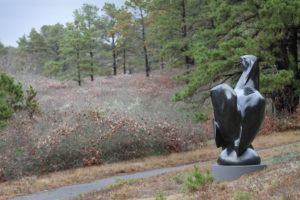
“Forgetting is another kind of extinction,” artist Todd McGrain said to me when I interviewed him for my blog, Eco-Now, in 2012. For ten years he had been creating larger-than-life sculptures of birds formerly common in North America, such as the passenger pigeon, to memorialize them. “These birds are not commonly known,” he has written elsewhere, “and they ought to be… It’s such a thorough erasing.”
Since the year 1500, nine hundred species have become extinct, yet their stories are not being told. This loss is a crisis in human values, as our relatives on the tree of life are disappearing under our watch and because of our actions. Aside from a few high profile extinctions, like the passenger pigeon and the dodo, most lost species are unknown to the general public, and the danger of forgetting part of our biological heritage is great. There are no historical parallels here. Aldo Leopold said, “For one species to mourn another is a new thing under the sun.”
The recent animal extinctions include twenty-eight reptiles, thirty-four amphibians, sixty-three fish, sixty-three insects, ninety-two mammals, one hundred and sixty-six birds and more than three hundred mollusks. Who are these animals? Where did they live? What do we know of their biology and natural history? Each animal had its own evolutionary history, ecological niche and characteristics that made it a unique form of life. In the long history of life, they were survivors, winners. But they have disappeared from the Earth due to our actions and without proper recognizance.
A marsupial is over-hunted in Australia. A tree frog disappears in Panama. An ibex vanishes from the Pyrenees, a river dolphin from the Yangtze, a pigeon from the skies of North America. The wildness of the Earth, its beauty and bounty, is diminishing. Because our present attitude is still to dominate nature and extract its resources for our personal welfare — we tend to ignore what we’re losing in favor of jobs and economic gain — these lost species become sacrifices for so-called progress. Seeing ourselves as apart from nature, rather than a part of nature, leaves us ill-equipped to see an extinction as an impoverishment of our world, a lost opportunity for us to wonder at something unique and beautiful.
This makes November 30: Remembrance Day for Lost Species all the more important. In her essay, “Working Through Environmental Despair,” Joanna Macy argues for the importance of expressing grief in the face of environmental degradation and loss. Because the changes we observe are subtle and we don’t see how they are related, we may deny their importance and live as if nothing has changed. This denial is a strategy that we employ to allay our various fears, such as fear of pain, fear of appearing morbid (we don’t want to be seen as doom and gloom), fear of appearing stupid (we want to express concerns but don’t have an immediate solution), fear of guilt (can we say anything about it without being implicated), fear of causing distress (we don’t want to be a killjoy), fear of appearing unpatriotic (aren’t our concerns contrary to our country’s dominant paradigm), fear of appearing too emotional (rationality is favored over display of feelings), and fear of feeling powerless (we shrink our sphere of attention to areas where we can be in charge). The result of all this is to narrow our awareness and consequently dull our response to the world.
Until we acknowledge the environmental loss and the pain we feel for the world through grief, Macy contends, our creative response will be crippled. Experiencing the pain is a measure of our care for the world, and expressing and sharing it opens the way to knowing our belonging and to our power.
Grief is one of our most private actions. And one of our most vital. Though I’ve been thinking about recently extinct species for several years now, I don’t yet have a ritual for their remembrance. Perhaps I will listen to a recording of the song of the o’o, or search the Internet for other recordings of endlings, like Toughie, or Benjamin, or peruse the incredible archive of sounds collected by Bernie Krause. Maybe I’ll try my hand at sketching once again, and sketch a few extinct animals. And perhaps I’ll listen to Mussorgsky’s Pictures at an Exhibition, written as a memorial for a friend. I want to hear the bells at the Great Gate of Kiev ring loud, loud.
(Parts of this were adapted from an unpublished essay and the introduction to my book, Brief Eulogies for Lost Animals, published in 2017 by Pen and Anvil.)
One thought on “Remembrance Day for Lost Species”
Comments are closed.